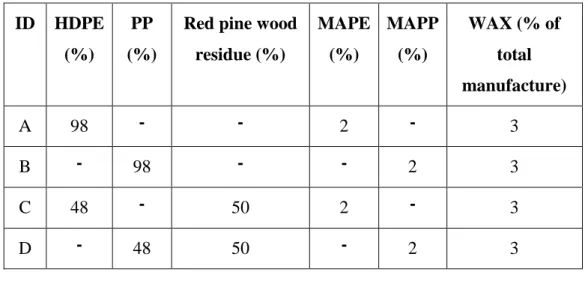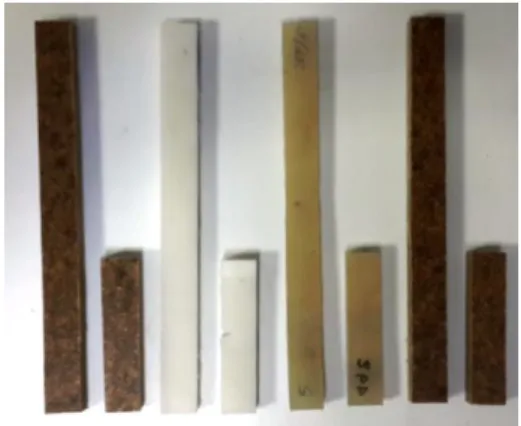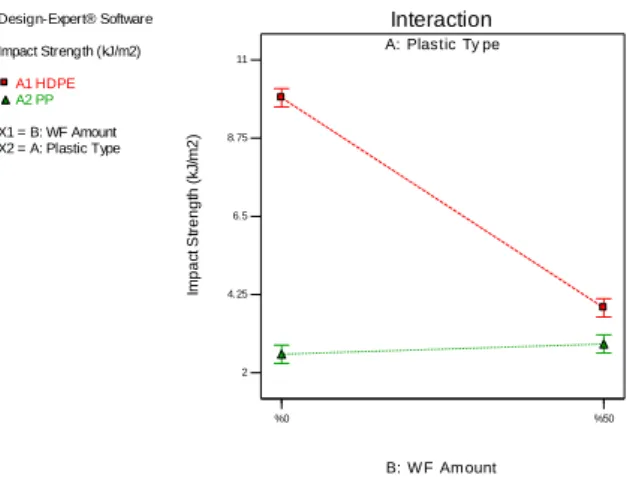1005
UTILIZATION OF RED PİNE WOD RESIDUE IN THE MANUFACTURE OF THERMOPLASTIC BASED POLYMER COMPOSITES
İbrahim Halil BAŞBOĞA1,*, Kadir KARAKUŞ1
ve Fatih MENGELOĞLU1,2
1, Kahramanmaras Sütçü Imam University (KSU) , Faculty of Forestry, Dept. of Forest Industry Engineering, Kahramanmaras/TURKEY
2, Kahramanmaras Sütçü Imam University (KSU), Graduate School of Natural & Applied Sciences, Dep. of Materials Science and Technology,
Kahramanmaras/TURKEY
*ihbasboga@ksu.edu.tr, karakus@ksu.edu.tr, fmengelo@ksu.edu.tr
Abstract
Thermoplastic-based polymer composites combine thermoplastic materials like polystyrene (PS), polypropylene (PP), polyethylene (PE), polyvinyl chloride (PVC), etc. and filling/reinforcing material like glass fiber, wood fiber, agricultural based fiber, etc. In this study, the utilization of red pine wood flour in the production of
thermoplastic-based composite as filling materialwas investigated. The effect of red pine wood waste
loading on the mechanical properties of the manufactured composites was determined. High density polyethylene (HDPE) and polypropylene (PP) were used as thermoplastic
polymer and the red pine sawdust were evaluated as filler. Composite samples were
produced using combination of extrusion and compression molding methods. The mechanical properties (tensile, flexural and impact resistance) of the produced composites were determined in accordance with ASTM standards.
Keywords: Thermoplastic, Composite, Mechanical properties, Compression molding
1. Introduction
The composite material combines two or more physically different materials to achieve better properties than constituent materials. There is a growing interest on
1006
lignocellulosic material (wood dust, wheat straw flour, etc.) filled thermoplastic composites due to their availability, renewability, cost, eco-friendliness and ease of processing [1].
In previous studies, polystyrene (PS), polypropylene (PP), polyethylene (PE), polyvinyl chloride (PVC), etc. as thermoplastic materials and wood flour, agricultural residue and industrial lignocellulosic waste as lignocellulosic filler were used in polymeric composites. The wood flours were obtained from pine, poplar, beech, eucalyptus, etc. The agricultural residues were wheat straw, rice straw, sunflower stalk, peanut shell, walnut shell, nutshell, pepper stem, etc. Industrial lignocellulosic waste was middle-density fiberboard production residues [2, 3, 4, 5, 6].
Wood processing residues has a great potential to be used in thermoplastic composites. 362 million cubic meters timber and 88 million cubic meters plywood were produced in the world between 2010 and 2011 [7]. In that time, 6,2 million cubic meters timber and 200 thousand cubic meters plywood were also produced in Turkey [7]. Timber and plywood manufacturing process produces roughly 50% and 40% residue, respectively [8]. Most of the lignocellulosic band saw residues which is substantially composed from end of production in sawmill was burned for producing energy. This great resource can be utilized in the production of lignocellulosic polymer composites as a filler material. For this purpose, the utilization of red pine sawdust collected from pallet manufactures in the city of Mersin, Turkey in high-density polyethylene-based and polypropylene-based thermoplastic composites was investigated. Mechanical properties of the produced composite were determined and compared with standards.
2. Materials and Methods
2.1 Materials
High-density polyethylene (HDPE) and polypropylene (PP) were used as thermoplastic matrix and red pine sawdust (RPS) were used as organic filler. Maleic anhydrite grafted polyethylene (Licocene PEMA 4351 by Clarient) and maleic anhydrite grafted polypropylene (Licomont AR 504 by Clariant) were utilized as coupling agents.
1007
Paraffin wax (K.130.1000) was used as a lubricant. RPS were collected from pallet mill
in the city of Mersin, Turkey. Descriptions of coupling agents were given in Table1.
Table 1. Descriptions of the coupling agents used in this study.
Descriptions Licocene PEMA 4351
(MAPE)
Licomont AR 504 (MAPP)
Appearance White fine grain Yellowish fine grain
Softening point 123°C 156°C
Acid Value 43 mg KOH/g 41 mg KOH/g
Density at 23°C 0.99 g/cm3 0.91 g/cm3 Viscosity at 140 °C 300 mPa.s 800 mPa.s 2.2 Methods 2.2.1 Composite Manufacturing
Red pine sawdust (RPS) was used as received from the plant. Particle distribution was given in Figure 1. The experimental design of the study was presented Table 2. Depending on the formulation given HDPE or PP, RPS, MAPE or MAPP and paraffin wax were dry-mixed in a high-intensity mixer to produce a homogeneous blend. These blends were compounded in a single-screw extruder (Figure 2) at 50 rpm screw speed in
the temperatures (barrel to die) of 170-180-185-190-200 0C. Extruded samples were
cooled in water pool and then granulated into pellets. The pellets were dried in oven at
103 0C (±2) for 24 hours. Dried pellets were compression molded (Figure 3) at
5500-6000 psi and temperatures of 175 0C for HDPE and 200 0C for PP in a hot press with
cooling capabilities. Boards in the size of 250mm by 250mm by 10mm were produced and testing samples in the sizes given in corresponding ASTM standards were cut (Figure 4).
1008
Fig 1. Particle distribution (%)
Table 2. Manufacture schedule ID HDPE
(%)
PP (%)
Red pine wood residue (%) MAPE (%) MAPP (%) WAX (% of total manufacture) A 98 - - 2 - 3 B - 98 - - 2 3 C 48 - 50 2 - 3 D - 48 50 - 2 3
1009
Fig 3. HDPE composite board Fig 4. Testing samples
2.2.2 Property Testing
Flexural, tensile and impact properties of all samples were determined. Five samples were tested for each test and each group. The flexural tests, tensile tests and impact tests were conducted in accordance with ASTM D 790, ASTM D 683 and ASTM D 256, respectively. Zwick/Roell 10KN Testing Machine was used for flexural tests and tensile tests. HIT5.5P impact testing machine, manufactured by Zwick™ was used while notched impact samples were being tested after the notches had been added using a Polytest notching cutter by RayRan™.
3. Results and Discussion
3.1 Mechanical Properties
In this study, flexural, tensile and impact properties of all samples were determined. The results of tests are summarized in Table 3. The graphs of mechanical properties are given in Figure 5-7.
1010
Table 3. Summary of results
Tensile properties include tensile strength, tensile modulus and elongation at break. The results showed that filler loading substantially affected the tensile strength (P<0,0001). With the rise of filler loading tensile strength was reduced in both composites. To mention of tensile modulus, rise of filler loading significantly increased the tensile modulus for both composites (P<0.0001). Similar results for other wood flours filled polymer composites were also reported [9, 10, 11]. Significant reduction by addition of filler in elongation at break values for HDPE was more pronounced than PP matrix. Flexural properties include flexural strength and flexural modulus. The results showed that the flexural strengths are significantly affected by filler loading (P<0.0001). Similar results were also reported in the flexural strength of other wood flour filled
ID Tensile Strength (MPa) Tensile Modulus ( MPa) Elongation at Break (%) Flexural Strength (MPa) Flexural Modulus (MPa) Impact Properties (Kj/m2) A 22,138 (0,445)* 284,334 (12,438) 54,486 (10,3) 38,306 (1,523) 972,468 (41,348) 9,912 (0,638) B 25,236 (3,628) 314,66 (23,808) 12,664 (2,658) 52,482 (3,350) 1234,71 (105,160) 2,534 (0,392) C 14,662 (0,565) 431,494 (110,429) 4,336 (0,588) 31,242 (0,945) 2078,068 (55,349) 3,868 (0,181) D 16,734 (0,542) 572,698 (14,244) 3,846 (0,203) 32,986 (0,928) 2172,046 (71,460) 2,828 (0,153)
1011
thermoplastic composites [12, 13, 14]. With filler loading flexural strength was reduced for HDPE and PP based composites.
For polyolefin-based plastic lumber decking boards, ASTM D 6662 (2001) standard requires the minimum flexural strength of 6.9 MPa (1,000 psi). Both composites produced in this study provided flexural strength values (7-50 MPa) that are over the requirement by the standard. To mention of flexural modulus, addition of filler raised the flexural modulus. ASTM D 6662 (2001) standard requires the minimum flexural modulus of 340 MPa (50,000 psi) for polyolefin-based plastic lumber decking boards. Both composites produced in this study provided flexural modulus values (363-1700 MPa) over the required standards.
In the case of Izod impact strength, the results showed that filler loading significantly affected the impact strength (P<0.0001). Addition red pine wood residue significantly reduced the impact strength. In composite materials, improved adhesion usually changes the mode of failure from “fiber pull out” to fiber breakage, which usually requires less energy. Similar findings were reported in other studies for different wood flours or fibers [15].
Design-Expert® Software Tensile Strength (MPa)
A1 HDPE A2 PP X1 = B: WF Amount X2 = A: Plastic Type A: Plastic Ty pe %0 %50 Interaction B: W F Am ount T e n s il e S tr e n g th ( M P a ) 13.0 16.8 20.5 24.3 28.0 (a) Design-Expert® Software Tensile Modulus (MPa)
A1 HDPE A2 PP X1 = B: WF Amount X2 = A: Plastic Type A: Plastic Ty pe %0 %50 Interaction B: W F Am ount T e n s il e M o d u lu s ( M P a ) 210 282.5 355 427.5 500 (b)
1012 Design-Expert® Software EatB (%) B1 %0 B2 %50 X1 = A: Plastic Type X2 = B: WF Amount B: W F Am ount HDPE PP Interaction A: Plastic Ty pe E a tB ( % ) 0 17 35 52 69 (c)
Fig 5. Tensile properties a) tensile strength, b) tensile modulus & c) elongation at break
Design-Expert® Software Flexural Strength (MPa)
A1 HDPE A2 PP X1 = B: WF Amount X2 = A: Plastic Type A: Plastic Ty pe %0 %50 Interaction B: W F Am ount F le x u ra l S tr e n g th ( M P a ) 29.0 35.5 42.0 48.5 55.0 (a) Design-Expert® Software Flexural Modulus (MPa)
A1 HDPE A2 PP X1 = B: WF Amount X2 = A: Plastic Type A: Plastic Ty pe %0 %50 Interaction B: W F Am ount F le xu ra l M o d u lu s (M P a ) 900 1250 1600 1950 2300 (b)
1013 Design-Expert® Software Impact Strength (kJ/m2) A1 HDPE A2 PP X1 = B: WF Amount X2 = A: Plastic Type A: Plastic Ty pe %0 %50 Interaction B: W F Am ount Im p a ct S tr e n g th ( kJ /m 2 ) 2 4.25 6.5 8.75 11
Fig 7. Impact properties
4. Conclusion
In this study, thermoplastic composites which obtain HDPE and PP as a polymer matrix and red pine wood residue as lignocellulosic filler have been produced. Mechanical properties such as tensile, flexural and impact strength is determined for the produced thermoplastic composites. Produced polymer composites have enough mechanical properties according to ASTM D 6662 (2001). Red pine wood residue can be utilized as filler for HDPE and PP based plastic composites. The utilization of the red pine wood residue flours in plastic industry could provide a new income.
5. Acknowledgements
This research was supported by The Scientific and Technological Research Council of Turkey (TUBİTAK) (Project number: 113O254).
6. References
[1] Mengeloglu F, Karakus K. Thermal degradation, mechanical properties and morphology of wheat straw flour filled recycled thermoplastic, Sensors 2008; 8: 497-516.
1014
[2] Acar H. MDF Tozu ve Pirinç Sapı Atıklarının Termoplastik Kompozitlerin Üretiminde Değerlendirilmesi, Yüksek Lisans Tezi, KSÜ, Fen Bilimleri Enstitüsü, 2014.
[3] Avcı E. Ahşap Plastik Kompozitlerin Kullanım Performansları Üzerine Araştırmalar, Doktora Tezi, İstanbul Üniversitesi, Fen Bilimleri Enstitüsü, 2012.
[4] Dönmez Çavdar A. Farklı Lignoselülozik ve Termoplastik Maddelerle Üretilen Odun-Plastik Kompozitlerin Özelliklerinin İncelenmesi, Doktora Tezi, KTÜ, Fen Bilimleri Enstitüsü, 2011.
[5] Karakuş K. Üniversitemizdeki Polietilen ve Polipropilen Atıkların Polimer Kompozit Üretiminde Değerlindirilmesi, Yüksek Lisans Tezi, KSÜ, Fen Bilimleri Enstitüsü, 2008.
[6] Mengeloglu F, Kabakci A. Determination of Thermal Properties and Morphology of Eucalyptus Wood Residue Filled High Density Polyethylene Composites. Int. J. Mol. Sci. 2008; 9: 107–119.
[7] Türkiye Orman Ürünleri Meclisi Sektör Raporu, 2011.
[8] Saraçoğlu N. Orman Artıkları, Yıllık Bitki, Tarımsal ve Fabrikasyon Atıklarının Enerji Üretiminde Değerlendirilmesi, Kırsal Çevre Yıllığı Ankara 2002; 20-30.
[9] Mengeloglu F, Kurt R, Gardner D.J. & Oneil S. Mechanical Properties of Extruded High Density Polyethylene and polypropylene Wood Flour Decking Board, Iranian Polymer Journal 2007; 16(7): 477-487.
[10] Qiu W, Endo T. & Hirotsu T. Interfacial Interactions of A Novel Mechanochemical Composite of Cellulose with Maleated Polypropylene, J. Appl. Polym. Sci. 2004; 94: 1326-1335.
[11] Wang Y, Yeh F.C, Lai S.M, Chan H.C. & Shen H.F. Effectiveness of Functionalized Polyolefins As Compatibilizers for Polyethylene/Wood Flour Composites, Polym. Eng. Sci. 2003; 43 (4): 933-945.
1015
[12] Chan J.H. & Balke S.T. The Thermal Degradation Kinetics of Polypropylene: Part II. Time-temperature Superposition, Polym. Degrad. Stabil. 1997; 57(2): 127-134. [13] Li Q. & Matuana L.M. Effectiveness of Maleated and Acryclic Acid- Unctionalized Polyolefin Coupling Agents for HDPE-Wood-Flour Composites, J. Thermoplast. Compos. 2003; 16: 551-564.
[14] Yang H.S, Wolcott M.P, Kim H.S, Kim S. & Kim H.J. Effect of Different Compatibilizing Agents on The Mechanical Properties of Lignocellulosic Material Filled Polyethylene Bio-Composites, Compos. Struct. 2007; 79: 369-375.
[15] Mengeloglu F, Matuana L.M. & King, J. Effects of Impact Modifiers on The Properties of Rigid PVC/Wood-Fiber Composites, J. Vinyl. Addit. Techn. 2000; 6(3): 153-157.
[16] ASTM (2000). “D 256: Standard Test Methods for Impact Resistance of Plastics and Electrical Insulating Materials” Philadelphia
[17] ASTM (2001). “D 638: Standard Test Methods for Tensile Properties of Plastics” Philadelphia
[18] ASTM (2001). “D 6662: Standard Specification for Polyolefin-Based Plastic Lumber” Philadelphia
[19] ASTM (2003). “D 790: Standard Test Methods for Flexural Properties of Unreinforced and reinforced Plastics and Electrical Insulating Materials” Philadelphia





